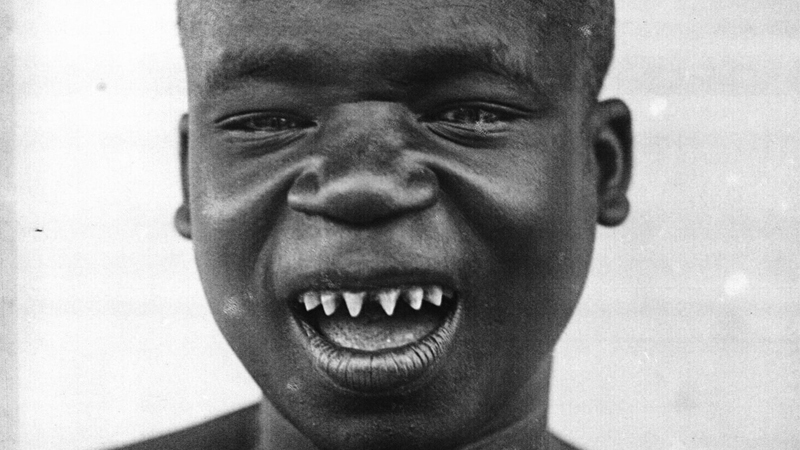|
Who was Ota Benga? How did this happen and why did it take 114 years for the zoo in question to apologise?

Tom Anstey | Planet Attractions | 01 Dec 2020

 Ota Benga was put on display as a human exhibit for a number of days Credit: Library of Congress Ota Benga was put on display as a human exhibit for a number of days Credit: Library of Congress
As horrific a concept as it sounds, the human zoo was an incredibly popular attraction in the 19th century.
As colonisation took hold of the world with Western Europe, the United States, Russia and Japan all expanding their empires, “explorers” came across new cultures never seen before by the West. People would be taken from these countries to be placed on display, with the exhibits designed primarily to emphasise the cultural differences between European and non-European people.
This concept was popular, so much so that during the 1870s, human zoos could be found in Paris, Hamburg, Antwerp, Barcelona, London, Milan, and New York. Interest was so high, that during the 1889 Paris World's Fair, a village of 400 indigenous people was presented as its major attraction. More than 29 million people visited the World’s Fair that year.
Ota Benga
A member of the Mbuti people, Ota Benga was a national of what was then the Belgian-controlled Independent State of the Congo.
King Leopold II of Belgium had established a militia in the country known as Force Publique. This group was established to control the natives, many of whom were forced into work to exploit the country’s large rubber supply. While carrying out these duties on behalf of the King, the militia attacked the Mbuti. During the assault, Benga's wife and two children were murdered. Benga was then captured by slave traders and put to work in an agricultural village.
In 1904, American businessman Samuel Phillips Verner travelled to Africa under contract from the Louisiana Purchase Exposition, assigned with the task of capturing and bringing to the US an assortment of pygmies to be part of a human zoo exhibition.
Here, Verner met Benga for the first time. He purchased him from the slavers reportedly in exchange for a pound of salt and some cloth. Verner would later claim he rescued Benga from the jaws of cannibals, though this is highly disputed.
Verner and Benga travelled together for several weeks in his search for more natives to bring to the US. Four men were recruited from Batwa village and another five from the Bakuba kingdom in Central Africa. All were displayed at the 1904 World’s Fair, with crowds of people gathering to observe them in mock-up replicas of their homes.
Following the exhibition, the Africans were returned to the Congo, with Benga accompanying Verner on his travels around the continent. Benga, whose entire tribe had been destroyed, reportedly chose to return with Verner to the US feeling he no longer had a place in Africa.

Samuel Phillips Verner claimed to have rescued Ota Benga from cannibals, which is highly disputed - Credit: LIBRARY OF CONGRESS
Opening correspondence
Now living in the US, Benga ended up staying in a spare room at the American Museum of Natural History. Much like the World’s Fair, Benga would entertain visitors, but reports indicate he soon became disillusioned with his situation.
It was on August 18, 1906, that Verner wrote a letter to the New York Zoological Park (Bronx Zoo), asking if it would take into its care three chimpanzees and two reptiles. At the suggestion of the museum curator, Henry Bumpus, Verner took Benga to the zoo. He was told he would have the job of maintaining the animal habitats but it wasn’t long until he became the focal point of the exhibition.
The transformation from keeper to exhibit was sly, with Benga encouraged to hang his hammock inside the enclosure and then to shoot his bow and arrow at a target also inside. The exhibit officially launched on September 8, 1906, where visitors would find Benga a part of the primate exhibit with a sign that read:
“The African Pygmy, "Ota Benga." Age, 23 years. Height, 4 feet 11 inches. Weight, 103 pounds. Brought from the Kasai River, Congo Free State, South Central Africa, by Dr. Samuel P. Verner. Exhibited each afternoon during September.”
An issue of the New York Times published on September 10, 1906, chronicled the result:
“Several thousand persons took the subway, the elevated and the surface cars to the New York Zoological Park in the Bronx yesterday, and there watched Ota Benga, the bushman, who has been put by the management on exhibition there in the monkey cage.
The bushman didn't seemed (sic) to mind it, and there could be no doubt that to the majority the joint man and monkey exhibition was the most interesting sight in the Bronx park. Over and over again, the crowd laughed at him. If he wonders why he does not show it.”

Ota Benga's sharp teeth were the result of tooth chipping, a practice that was popular among young men in the Congo at the time - Credit: LIBRARY OF CONGRESS
Making a stand
Reports suggest more than 400,000 people a day visited the zoo to see Benga. Zoo director William Hornaday considered him to be a “valuable spectacle” for his visitors but a group of black clergymen took obvious and immediate offence to this display.
Led by James H. Gordon, the group called for an immediate end to Benga’s incarceration. Following the controversy, Benga was allowed to move freely through the zoo but taunts from visitors provoked him to cause trouble and become violent.
Telling of Benga’s dire situation, in an article published in the New York Times, Robert Stuart MacArthur - a longtime pastor of the Calvary Baptist Church in New York City - said: “We send our missionaries to Africa to Christianize the people, and then we bring one here to brutalise him.”
After somewhere between three days and three weeks of captivity (the length of time is disputed by different sources), it was agreed that 23-year-old Benga would be moved to the Gordon’s Howard Coloured Orphan Asylum in New York rather than returning to his home.
Benga would spend a number of years at the orphanage before being relocated to Lynchburg, Virginia, in 1910 where he received formal schooling and religious training for the first time. He then got a job working at a tobacco factory, where he started saving his money in an attempt to return to Africa. In 1914 however, World War I had severely limited travel on passenger ships, effectively preventing Benga’s return home.
On March 20, 1916, overcome with depression, Ota Benga died by suicide. He was thought to be somewhere between 25 and 33 years old.
An overdue apology
One of the most shocking things about these events is that it took more than a century for the Bronx Zoo to admit its role in the scandal.
Newspapers following Benga’s captivity reported it as a prank. The March 6, 1907 edition of The New York Sun reads:
“When Prof. Verner came over here last summer with two valuable chimpanzees for the Bronx Zoo, Ota drifted along as their custodian. Ota handed his charges over to Dr. W. T. Hornaday, director of the Zoo, in prime condition, and made such a hit with the director that he was engaged as assistant keeper of the monkeys. In a little while Ota, who is of a sensitive nature, discovered that because he wasn’t a member of the Monkey Keeper’s Union, Local No. 1, the other keepers were pestering him by hanging cards on the cages in the primates’ house, which drew great crowds.
“These cards announced that at a certain hour every day Ota Benga would appear in the monkey cage and amuse the ladies and children. When an English speaking monk tipped Ota off that the other keepers were making a monkey of him he made things so warm around the Zoo that Director Hornaday gladly gave him his discharge papers after the clergymen offered to take him away.”
Newspapers reporting fallout from Benga’s captivity downplayed the incident. The Topeka Daily State Journal described protesters as “charitably disposed persons”, while another paper said: “They say it is slavery. The answer is that Ota can go when he pleases. Ota himself looks at the civilized colored brethren with horror and vows that he will not leave the park till Mr. Verner comes in a month or so to take him home to Africa.”
Accounts like these have contaminated the historic narrative, circulating stories that Benga was happy in captivity. The reality of the situation was that Benga would protest his captivity in the only way he could - by acting out and rebelling.
Over the last hundred-plus years, the Bronx Zoo failed to correct the misleading stories about Ota Benga and his time living there in captivity.
Zoo archives show that the officials involved in the scandal discussed creating a story where Ota Benga had been an employee, something the zoo had claimed to be true or refused to comment on up until July of this year.
Then, following a period where black rights were thrust to the forefront of the public consciousness, on Juneteenth (July 19) – a day that commemorates the end of slavery in the US – the Wildlife Conservation Society, which operates the Bronx Zoo, finally accepted its role in the events, apologising for its treatment of Benga and the promotion of eugenics.
“As the United States confronts its legacy of racism and the brutal killings that have led to mass protests around the world, this, too, is an important moment in history to reflect on WCS’s own history, and the persistence of racism in our institution and in human society. The United States is discovering its moral center and so must WCS,” said the statement from WCS president and CEO, Cristian Samper.
“First, we condemn the treatment of a young man from Central Africa’s Mbuti people named Ota Benga, who lived at the Bronx Zoo for a month and was displayed in the Monkey House for several days during the week of September 8, 1906. Crowds of hundreds gaped at this shameful spectacle until public outcry led to Ota Benga being removed from exhibit. This particular degradation began in 1904 when he was brought to the United States forcibly from present-day Democratic Republic of Congo by a disreputable businessman to be exploited at the St. Louis World’s Fair. He left the zoo after a local Black minister, Reverend James Gordon, arranged for him to stay at the orphanage he directed in Weeksville, Brooklyn. Unable to return home to Africa due to travel restrictions caused by the outbreak of World War I, Ota Benga would tragically take his own life in 1916 in Virginia, a victim of the racism that robbed him of his humanity.
We further condemn bigoted actions and attitudes in the early 1900s toward non-whites - especially African Americans and recent immigrants - that characterized the leadership in the United States at many notable institutions, including our own. Specifically, we condemn and denounce the writings and philosophies advanced by Madison Grant, a founder of the New York Zoological Society (NYZS). To the lasting shame of this institution, Madison Grant authored a book called “The Passing of the Great Race,” a eugenics-based work of pseudoscientific racism. This book, praised by another NYZS founder, Henry Fairfield Osborn, was cited by Nazis on trial at Nuremberg to justify their actions.
Today, we apologize for our organization's role in these injustices. We deeply regret that many people and generations have been hurt and betrayed by these actions. We recognize that overt and systemic anti-Black racism persists, and our institution must play a greater role in recognizing this fact and doing more to overcome these challenges.”
What now?
Acknowledging its mistakes, WCS has made all of its known records related to Ota Benga available for anyone to view online. There have since been calls for the conservation society to follow up its apology with public education sessions, not only about Ota Benga, but about the history of conservation and its dark ties to eugenics. There have also been calls to name its education centre after Ota Benga, whose life will always be tied to that of the zoo which put him on display with its animals.
“When he was brought down to Lynchburg, he lived in my family's home. I was only two and a half, but my brother Hunter knew him well,” said then 92-year-old Carrie Ellen McCray, speaking to NPR in 2006 about Ota Benga.
“If you read some of the old history books or go way back to even ancient history and see what man does to man, you cringe. This whole experience - to put him in a cage with an ape. People can hardly believe that this happened, but it did.”
Visitor attractions
|
|






Supplier Showcase 2025: The biggest attractions projects landing worldwide this year
|